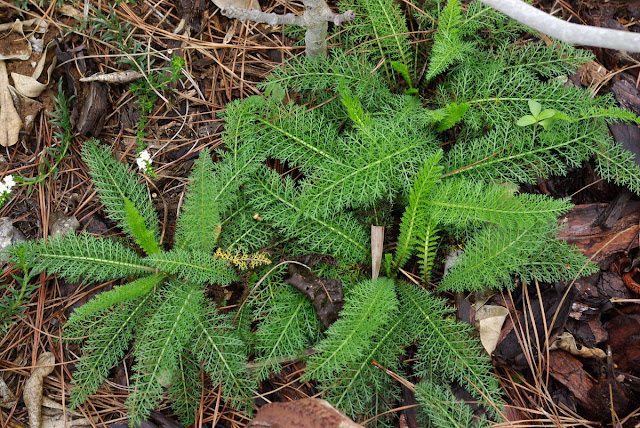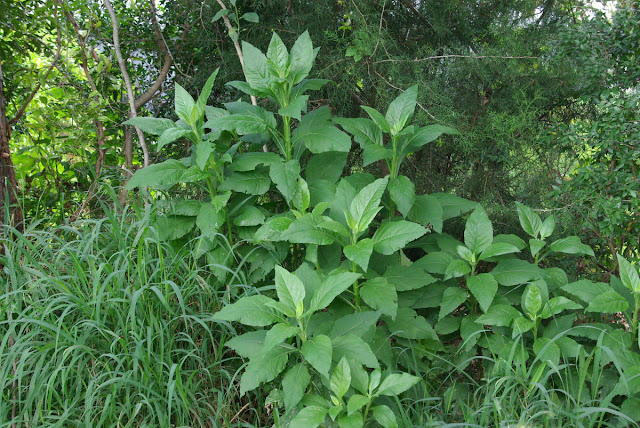On Saturday, February 26, 2011, Ryan Leavengood and I visited the home of fellow Florida Native Plant Society member, Michael Manna. The following is a brief account of that visit.
The variety of plants grown by Michael was amazing but four principal groups stood out in my mind: Florida native plants; carnivorous plants; utilitarian plants such as edible, medicinal, or herbal plants; and a variety of tropical plants, most notably, orchids and bromeliads. One remarkable plant that did not fit any of these categories was a venerable Florida cracker rose that was growing to perfection and had beautiful, dark green foliage unblemished by even a hint of disease or insect damage. Among the utilitarian plants, there were a variety of spinach substitutes, as well as a dwarf everbearing mulberry tree, with the fruits of the latter proving a great delight to Michael's daughter, the 18-month-old Willow.
Michael is perhaps best known for his carnivorous plant collection and he grows a wide variety of butterworts (Pinguicula species) and Asian pitcher plants (Nepenthes species). Also well represented are sundews (Drosera species) and American pitcher plants (Sarracenia species). Unfortunately, at the time of our visit, the American pitcher plants were mostly dormant so we had to content ourselves with admiring the freshly developing flower buds, which promised a bountiful show of blossoms a little later in the year. Also present in Michael's collection of carnivorous plants was the Albany pitcher plant (Cephalotus follicularis), which grows in the vicinity of the town of Albany in southwestern Australia, as well as the rainbow plant (Byblis liniflora), also hailing from Australia and named for its linear leaves bedecked with dewy glands that beautifully glisten in the sunlight.
Although many Florida native trees and shrubs are grown by Michael, the most interesting native plants for me were the numerous native wildflowers that he cultivated. The list is a very long one and included many small, colorful plants that are rarely ever grown by gardeners of any kind, whether focusing on native plants or not. Among these were Polygala lutea (orange milkwort); Dichanthelium species (witchgrasses); Xyris species (yellow-eyed-grasses); and Viola species (wild violets), of which Michael had three different species, this being the largest number I have ever seen in a south Florida garden. Also noteworthy, among so many other noteworthy plants, was a tub of the native yellow-flowered water-lily, Nymphaea mexicana.
The images below represent a small sample of the many beautiful plants Ryan and I observed during our visit:
 |
| Achillea millefolium (yarrow) is grown for both its ornamental and herbal uses. |
 |
| Brugmansia (angel's trumpet). |
 |
| Cephalotus follicularis, the Albany pitcher plant. |
 |
| Drosera binata var. binata, a striking sundew native to Australia and New Zealand. |
 |
| Drosera burmannii, an annual Asian sundew that readily spreads by way of self-sown seeds. |
 |
| A view of the greenhouse, where most of the Asian pitcher plants are kept. |
 |
| Pinguicula 'Aphrodite', a hybrid butterwort whose parents are Pinguicula agnata and Pinguicula moctezumae. |
 |
| Pinguicula gigantea, note the numerous tiny gnats that have been trapped by the plant. |
 |
| A beautifully grown old fashioned Florida cracker rose. |
 |
| The native Tillandsia fasciculata, one of many bromeliads in the collection. |
 |
| Verbesina virginica, white crownbeard, growing with the native grass, Panicum dichotomiflorum var. bartowense |
 |
| Viola palmata has dark violet-purple petals when the flowers first open. |
 |
| Viola palmata flowers continue to enlarge, and become more pale, as they age. |
© 2010 Rufino Osorio.















